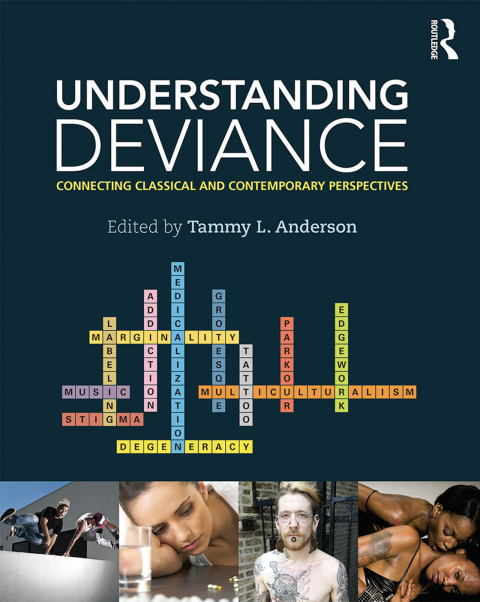Description
Efnisyfirlit
- Cover Page
- Half Title Page
- Series Page
- Title Page
- Copyright Page
- Contents
- Series Foreword
- Preface
- Acknowledgments
- Part 1: Classical and Contemporary Approaches to Deviance
- Section 1 Defining Deviance
- Introduction
- Rules for the Distinction of the Normal from the Pathological
- Notes on the Sociology of Deviance
- Outsiders: Definitions of Deviance
- Defining Deviancy Down
- Connections: Definitions of Deviance and the Case of Underage Drinking and Drunk Driving
- Critical Thinking Questions
- Section 2 Functionalism, Anomie, General Strain Theory
- Introduction
- Social Structure and Anomie
- Homeboys, New Jacks, and Anomie
- A General Strain Theory of Community Differences in Crime Rates
- Connections: Understanding Doping in Elite Sports through Anomie and General Strain Perspectives
- Critical Thinking Questions
- Section 3 Social Disorganization and Collective Efficacy
- Introduction
- Juvenile Delinquency and Urban Areas
- Collective Efficacy Theory: Lessons Learned and Directions for Future Inquiry
- The Urban Ecology of Bias Crime: A Study of Disorganized and Defended Neighborhoods
- Connections: The Prison Community from a Social Disorganization and Collective Efficacy Perspective
- Critical Thinking Questions
- Section 4 Social Pathology, Degeneracy, and Medicalization
- Introduction
- Social Pathology
- Whatever Happened to Social Pathology? Conceptual Fashions and the Sociology of Deviance
- The Shifting Engines of Medicalization
- Connections: Mental Illness as Degeneracy, Disease, and Genetics
- Critical Thinking Questions
- Section 5 Labeling, Resistance, and Edgework
- Introduction
- Beyond Mead: The Societal Reaction to Deviance
- Edgework: A Social Psychological Analysis of Voluntary Risk-Taking
- Resistance as Edgework in Violent Intimate Relationships of Drug-Involved Women
- Connections: Parkour through Labeling, Resistance, and Edgework
- Critical Thinking Questions
- Section 6 Stigma, Carnival, and the Grotesque Body
- Introduction
- Stigma and Social Identity
- Why Do People Get Tattoos?
- Big Handsome Men, Bears, and Others: Virtual Constructions of “Fat Male Embodiment”
- Connections: Explaining Body Deviance with Stigma and Carnival of the Grotesque
- Critical Thinking Questions
- Section 7 Deviant Careers, Identity, and Lifecourse Criminology
- Introduction
- Outsiders: Kinds of Deviance: A Sequential Model
- Crime and Deviance in the Life-Course
- Weighing the Consequences of a Deviant Career: Factors Leading to an Exit From Prostitution
- Connections: Deviant Career and Life-Course Criminology Using Street Prostitution
- Critical Thinking Questions
- Section 8 Moral Panics and Risk Society
- Introduction
- Deviance and Moral Panics
- Moral Panics: Culture, Politics, and Social Construction
- Moral Panic Versus the Risk Society: The Implications of the Changing Sites of Social Anxiety
- Connections: [A]moral Panics and Risk in Contemporary Drug and Viral Pandemic Claims
- Critical Thinking Questions
- Section 9 Critical Criminology, Culture of Control, Mass Incarceration
- Introduction
- The Child Savers: Chapter 5: The Child-Saving Movement in Illinois
- The Hypercriminalization of Black and Latino Male Youth in the Era of Mass Incarceration
- Governing through Crime: Safe Schools: Reforming Education through Crime
- Connections: The Social Control of Youth Across Institutional Spheres
- Critical Thinking Questions
- Part 2: Emergent Possibilities and the Future of Deviance
- Section 10 Queer Theory, Communities, and Citizenship
- Introduction
- Coming Out All Over: Deviants and the Politics of Social Problems
- There Goes the Gayborhood?
- Queer Presences and Absences: Citizenship, Community, Diversity—or Death
- Connections: HIV and Bugchasers across Queer Collectives
- Critical Thinking Questions
- Section 11 Critical Race Theory, Multiculturalism, and Identity
- Introduction
- Deviance as Resistance: A New Research Agenda for the Study of Black Politics
- The Battle of Los Angeles: The Cultural Politics of Chicana/o Music in the Greater Eastside
- “I Was Aggressive for the Streets, Pretty for the Pictures”: Gender, Difference, and the Inner-City Girl
- Connections: Marginality, Identity, and Music Scenes
- Critical Thinking Questions
- Section 12 Biomedicalization, Biopower, and Biocitizens
- Introduction
- The Medicalization of Unhappiness
- “Civilizing Technologies” and the Control of Deviance
- Connections: Biomedicalization of Drug Addiction and the Reproduction of Inequality
- Critical Thinking Questions
- Contributor Biographies
- Credits
- Index






Reviews
There are no reviews yet.